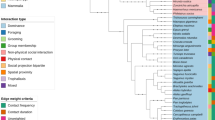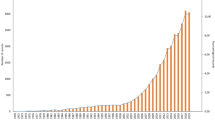Abstract
Social network analysis is an increasingly popular tool for the study of the fine-scale and global social structure of animals. It has attracted particular attention by those attempting to unravel social structure in fission–fusion populations. It is clear that the social network approach offers some exciting opportunities for gaining new insights into social systems. However, some of the practices which are currently being used in the animal social networks literature are at worst questionable and at best over-enthusiastic. We highlight some of the areas of method, analysis and interpretation in which greater care may be needed in order to ensure that the biology we extract from our networks is robust. In particular, we suggest that more attention should be given to whether relational data are representative, the potential effect of observational errors and the choice and use of statistical tests. The importance of replication and manipulation must not be forgotten, and the interpretation of results requires care.


Similar content being viewed by others
References
Bejder L, Fletcher D, Brager S (1998) A method for testing association patterns of social animals. Anim Behav 56:719–725
Boccaletti S, Latora V, Moreno Y, Chavez M, Hwang D-U (2006) Complex networks: structure and dynamics. Phys Rep 424:175–308
Cairns SJ, Schwager SJ (1987) A comparison of association indexes. Anim Behav 35:1454–1469
Corner LAL, Pfeiffer DU, Morris RS (2003) Social-network analysis of mycobacterium bovis transmission among captive brushtail possums (Trichosurus vulpecula). Prev Vet Med 59(3):147–167
Croft DP, Krause J, James R (2004) Social networks in the guppy (Poecilia reticulata). Proc Roy Soc London B 271:S516–S519
Croft DP, James R, Ward AJW, Botham MS, Mawdsley D, Krause J (2005) Assortative interactions and social networks in fish. Oecologia 143(2):211–219
Croft DP, James R, Thomas POR, Hathaway C, Mawdsley D, Laland KN, Krause J (2006) Social structure and co-operative interactions in a wild population of guppies (Poecilia reticulata). Behav Ecol Sociobiol 59(5):644–650
Croft DP, James R, Krause J (2008) Exploring Animal Social Networks. Princeton University Press, Princeton
Cross PC, Lloyd-Smith JO, Bowers JA, Hay CT, Hofmeyr M, Getz WM (2004) Integrating association data and disease dynamics in a social ungulate: bovine tuberculosis in African buffalo in the Kruger national park. Ann Zool Fenn 41(6):879–892
Faust K (2006) Comparing social networks: size, density, and local structure. Metodol zv 3(2):185–216
Faust K, Skvoretz J (2002) Comparing networks across space and time, size and species. Sociol Method 32:267–299
Flack JC, Girvan M, de Waal FBM, Krakauer DC (2006) Policing stabilizes construction of social niches in primates. Nature 439(7075):426–429
Franks DW, James R, Noble J, Ruxton GD (2009) A foundation for developing a methodology for social network sampling. Behav Ecol Sociobiol. doi:10.1007/s00265-009-0729-2
Hemelrijk CK (1990a) Models of, and tests for, reciprocity, unidirectionality and other social-interaction patterns at a group level. Anim Behav 39:1013–1029
Hemelrijk CK (1990b) A matrix partial correlation test used in investigations of reciprocity and other social-interaction patterns at group level. J Theor Biol 143(3):405–420
Hoare DJ, Ruxton GD, Godin J-GJ, Krause J (2000) The social organisation of free-ranging fish shoals. Oikos 89(3):546–554
Krause J, Ruxton GD (2002) Living in groups. Oxford University Press Oxford
Krause J, Croft DP, James R (2007) Social network theory in the behavioural sciences: potential applications. Behav Ecol Sociobiol 62:15–27
Krause J, Lusseau D, James R (2009) Animal social networks: an introduction. Behav Ecol Sociobiol. doi:10.1007/s00265-009-0747-0
Krause S, Mattner L, James R, Guttridge T, Corcoran MJ, Gruber SH, Krause J (2009) Social network analysis and valid Markov chain Monte Carlo tests of null models. Behav Ecol Sociobiol. doi:10.1007/s00265-009-0746-1
Laumann E, Marsden P, Prensky D (1983) The boundary specification problem in network analysis. In: Burt R, Minor M (eds) Applied network analysis. Sage Publications London, pp 18-34
Lusseau D (2003) The emergent properties of a dolphin social network. Proc Roy Soc Lond B 270(Suppl 2):S186–S188
Lusseau D, Newman MEJ (2004) Identifying the role that animals play in their social networks. Proc Roy Soc Lond B 271:S477–S481
Lusseau D, Schneider K, Boisseau OJ, Haase P, Slooten Dawson SM (2003) The bottlenose dolphin community of doubtful sound features a large proportion of long-lasting associations—can geographic isolation explain this unique trait? Behav Ecol Sociobiol 54(4):396–405
Lusseau D, Wilson B, Hammond PS, Grellier K, Durban JW, Parsons KM, Barton TR, Thompson PM (2006) Quantifying the influence of sociality on population structure in bottlenose dolphins. J Anim Ecol 75:14–24
Lusseau D, Whitehead H, Gero S (2008) Incorporating uncertainty in the study of animal social networks. Anim Behav 75:1809–1815
Manly BFJ (1997) Randomization, bootstrap and monte carlo methods in biology. Chapman & Hall London
Mantel N (1967) The detection of disease clustering and a generalized regression approach. Cancer Res 27:209–220
Martin P, Bateson P (2007) Measuring behaviour: an introductory guide, 3rd edn. Cambridge University Press, Cambridge
McDonald DB (2007) Predicting fate from early connectivity in a social network. PNAS 104:10910–10914
McDonald DB (2009) Young-boy networks without kin clusters in a lek-mating manakin. Behav Ecol Sociobiol. doi:10.1007/s00265-009-0722-9
McDonald DB, Potts WK, Fitzpatrick JW, Woolfenden GE (1999) Contrasting genetic structures in sister species of North American scrub-jays. Proc Roy Soc Lond B 266:1117–1125
Newman MEJ (2001) Who is the best connected scientist? A study of scientific coauthorship networks. Phys Rev E 64:016131
Newman MEJ (2003a) The structure and function of complex networks. Siam Rev 45(2):167–256
Newman MEJ (2003b) Properties of highly clustered networks. Phys Rev E 68(2):026121
Ohtsuki H, Hauert C, Lieberman E, Nowak MA (2006) A simple rule for the evolution of cooperation on graphs and social networks. Nature 441(7092):502–505
Pastor-Satorras R, Vespignani A (2001) Epidemic spreading in scale-free networks. Phys Rev Lett 86(14):3200–3203
Sade DS, Dow MM (1994) Primate social networks. In: Wasserman S, Galaskiewicz J (eds) Advances in social network analysis. Sage Publications, California, pp 152–66
Scott J (2000) Social network analysis: a handbook. Sage Publications London
Sih A, Hanser SF, McHugh KA (2009) Social network theory: new insights and issues for behavioural ecologists. Behav Ecol Sociobiol. doi:10.1007/s00265-009-0725-6
Snijders TAB (2005) Models for longitudinal network data. In: Carrington PJ, Scott J, Wasserman S (eds) Models and methods in social network analysis. Cambridge University Press, New York, pp 215–247
Sundaresan SR, Fischhoff IR, Dushoff J, Rubenstein DI (2007) Network metrics reveal differences in social organization between two fission-fusion species, grevy's zebra and onager. Oecologia 151(1):140–149
Watts DJ, Strogatz SH (1998) Collective dynamics of 'small-world' networks. Nature 393(6684):440–442
Wey T, Blumstein DT, Shen W, Jordán F (2008) Social network analysis of animal behaviour: a promising tool for the study of sociality. Anim Behav 75:333–344
Whitehead H (2008) Analyzing animal societies: quantitative methods for vertebrate social analysis. University of Chicago Press, Chicago, p. 320
Whitehead H (2009) SOCPROG programs: analyzing animal social structures. Behav Ecol Sociobiol 63:765–778. doi:10.1007/s00265-008-0697-y
Whitehead H, Dufault S (1999) Techniques for analyzing vertebrate social structure using identified individuals: review and recommendations. Adv Study Behav 28:33–74
Whitehead H, Bejder L, Ottensmeyer AC (2005) Testing association patterns: issues arising and extensions. Anim Behav 69:e1–e6
Williams R, Lusseau D (2006) A killer whale social network is vulnerable to targeted removals. Biology Letters 2:497–500
Wittemyer G, Douglas-Hamilton I, Getz WM (2005) The socioecology of elephants: analysis of the processes creating multitiered social structures. Anim Behav 69:1357–1371
Wolf JBW, Mawdsley D, Trillmich F, James R (2007) Social structure in a colonial mammal: unravelling hidden structural layers and their foundations by network analysis. Anim Behav 74:1293–1302
Acknowledgements
We are grateful to Dan Franks, Stefan Krause, David Lusseau, David McDonald, Graeme Ruxton, Colin Tosh, Hal Whitehead, Jochen Wolf and the participants of the Halifax IEC symposium on social networks for comments and ideas. Funding was provided by the EPSRC and NERC.
Author information
Authors and Affiliations
Corresponding author
Additional information
Communicated by Guest Editor D. Lusseau
This contribution is part of the special issue “Social Networks: new perspectives” (Guest Editors: J. Krause, D. Lusseau and R. James).
Rights and permissions
About this article
Cite this article
James, R., Croft, D.P. & Krause, J. Potential banana skins in animal social network analysis. Behav Ecol Sociobiol 63, 989–997 (2009). https://doi.org/10.1007/s00265-009-0742-5
Received:
Revised:
Accepted:
Published:
Issue Date:
DOI: https://doi.org/10.1007/s00265-009-0742-5




